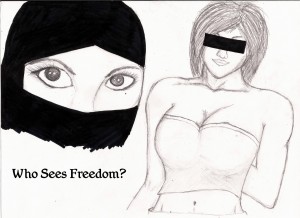Posters for Persepolis (Week 12)
Mason Hsieh
5/4/12
This creative project was inspired by the art and message of freedom in Persepolis, by Marjane Satrapi. The graphic novel is an autobiographic recounting of her childhood during the Islamic Revolution in Iran. The first page is of the comic is of her in a veil. She is ten years old and clearly not enthusiastic about this fashion choice. The veil itself became obligatory for all Iranian women to wear during this time period and came to symbolize both traditional religion and female oppression. As Marjane reaches adolescence, she, like many of her friends becomes obsessed with the Western life style. She buys jean jackets, Kim Wilde and the Camel cassette tapes, and even convinces her parents to smuggle in posters of her favorite American musicians. This leads to an odd dynamic as her body represents the synthesis of “East” and “West.” She is partially dressed in Western clothes, but has her hair veiled.
The discourse on Western and Islamic fashion and freedom really intrigued me. In the Western world, women are “free” to dress as they please, but often times are forced by the media and societal gaze to objectify themselves. Feminist theorists often critize this system, maintaining that Western women are “slaves” to the public’s gaze. On the other hand, in Marjane’s world and much of the Islamic sphere, women veil themselves. The argument has been made that the veil actually “liberates” women as it frees them from the judgmental, sexualizing gaze of society. However, in Marjane’s case, the veil has been imposed and forced upon her. It is national law that she veils herself in public.
Thus, my project is supposed to be a political poster that speaks to this debate over freedom in Western fashion and Islamic clothing. It questions which culture actually liberates their women. The woman on the left is veiled. Though this is not the type of veiling that Marjane has to undergo, it is an “extreme” form of veiling that I used to further juxtapose the two models. Only the veiled woman’s eyes are visible. On the other hand, the woman on the right is dressed in “Western” clothing. While this is also by no means the standard American fashion sense, I used the skimpy shirt and naked midriff to highlight how much of the Western woman’s body can be shown and still be culturally acceptable. This woman’s eyes are blacked out, suggesting that she is not seen as a real person by society. I implicate the viewer through my slogan. I ask them to look at the two women and decide who is more liberate. Is it the woman hidden behind the veil and may have no right to display her body in public, or the woman who feels she must objectify herself to the controlling social gaze? I ultimately ask the viewer to think about “Who sees freedom.”
